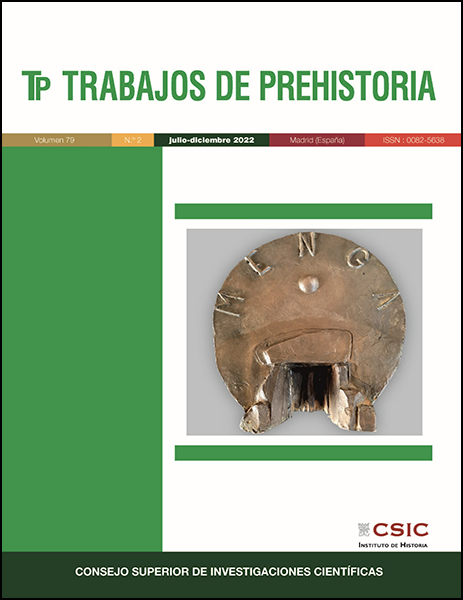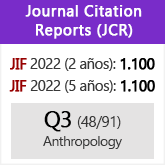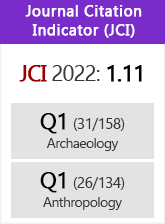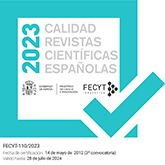La apropiación local de ideales guerreros en la Europa de la Edad del Bronce Final: una revisión del sitio de arte rupestre de Arroyo Tamujoso 8 y la estela de Cancho Roano (Badajoz, España)
DOI:
https://doi.org/10.3989/tp.2022.12302Palabras clave:
apropiación de ideales asociados con el guerrero, arte rupestre, estelas de guerrero, península ibérica, registro 3D de alta resolución, análisis espacial mediante SIG, cultura visual, armas metálicas, cadena operativa de la producción de arte rupestre, Edad del Bronce FinalResumen
Este estudio ofrece nuevos datos sobre la apropiación local de los ideales asociados al guerrero en Europa durante la Edad del Bronce Final a través del nuevo estudio de los grabados de Cancho Roano y Arroyo Tamujoso 8, situados en el Suroeste de la península ibérica, de sus soportes y contextos paisajísticos. Emplea tecnologías digitales de vanguardia para identificar algunos de los particularismos más distintivos de esa iconografía, revelando diversas respuestas a los ideales de guerrero que estaban en circulación en Europa durante dicho período. Para comprender los contextos de circulación desde una perspectiva local, también consideramos brevemente las conexiones multi-escala en las que estaban involucradas las comunidades que crearon estelas de guerrero en Iberia. El objetivo final de este artículo es sentar las bases para un próximo trabajo donde se comparan con mayor detalle la iconografía de las estelas de guerrero y la de los guerreros del arte rupestre escandinavo, teniendo también en cuenta otros aspectos.
Descargas
Citas
Álvarez Martínez, J. M. 2015: "El tajamar del Puente romano de Mérida y la navegabilidad del Ana." Revista de Estudios Extremeños 71; 37- 66.
Bertilsson, U.; Ling; J.; Bertilsson, C.; Potter, R.; and Horn, C. 2017: "The Kivik tomb: Bredarör enters into the digital arena - documented with OLS; SfM and RTI." In S. Bergerbrant, and A. Wessman (eds.): New perspectives on the Bronze Age. Archaeopress. Oxford: 289-306. https://doi.org/10.2307/j.ctv1pzk2c1.27
Brandherm, D. 2007: Las espadas del Bronce Final en la Península Ibérica y Baleares. Prähistorische Bronzefunde IV, 16, Franz Steiner Verlag. Stuttgart.
Bradley, R. 1998: The passage of arms. An archaeological analysis of prehistoric hoard and votive deposits. Oxbow Books. Oxford.
Bradley, R. 2000: An archaeology of natural places. Routledge. London & New York.
Bridgford, S. 2000: Weapons; warfare and society in Britain 1250- 750 BC. University of Sheffield. White Rose eTheses Online, uk.bl.ethos.327615
Bruck, J.; and Fontijn, D. 2013: "The myth of the chief: prestige goods; power and personhood in the European Bronze Age." The Oxford Handbook of the European Bronze Age. Oxford University Press. Oxford: 197-215. https://doi.org/10.1093/oxfordhb/9780199572861.013.0011
Bueno Ramírez, P.; Barroso Bermejo, R.; Balbín Behrmann, R. de; and Salvado, P. 2019: "Stone witnesses: armed stelae between the International Tagus and the Douro, Iberian Peninsula." SPAL - Revista de Prehistoria y Arqueología 28-2: 143-164. https://doi.org/10.12795/spal.2019.i28.17
Carrero, M.; Vilas, B.; and Vázquez, A. 2018: "Digital imaging techniques for recording and analysing prehistoric rock art panels in Galicia (NW Iberia)." Digital Applications in Archaeology and Cultural Heritage 8: 35-45. https://doi.org/10.1016/j.daach.2017.11.003
Celestino, S. 2001a: Estelas de guerrero y estelas diademadas. La precolonización y formación del mundo tartésico. Bellaterra. Barcelona.
Celestino, S. 2001b: Cancho Roano. Bartolomé Gil Santacruz. Madrid.
Celestino, S. 2001c: "Los santuarios de Cancho Roano: del indigenismo al orientalismo arquitectónico." In D. Ruiz, and S. Celestino (eds.): Arquitectura oriental y orientalizante en la Península Ibérica. Consejo Superior de Investigaciones Científicas. Madrid: 17-57.
Celestino, S.; and Rodríguez, E. 2018: "Cerro Borreguero. Un yacimiento clave para estudiar la transición entre el Bronce Final y el periodo tartésico en el valle del Guadiana." Trabajos de Prehistoria 75 (1): 172-180. https://doi.org/10.3989/tp.2018.12211
Colquhoun, I. 2015: The Bronze Swords of Ireland. Durham University. http://etheses.dur.ac.uk/11267/
Cultural Heritage Imaging 2011: Reflectance Transformation Imaging: Guide to Highlight Image Processing v1.4. Available at: http://culturalheritageimaging.org/What_We_Offer/Downloads/ rtibuilder/RTI_hlt_Processing_Guide_v14_beta.pdf> (last accessed: June 21, 2021), San Francisco.
Cultural Heritage Imaging 2013a: Reflectance Transformation Imaging: Guide to Highlight Image Capture v2.0. Available at: <http://culturalheritageimaging.org/What_We_Offer/Downloads/ RTI_Hlt_Capture_Guide_v2_0.pdf> (last accessed: June 21, 2021), San Francisco.
Cultural Heritage Imaging 2013b: Guide to RTIViewer v 1.1. Available at: <http://culturalheritageimaging.org/What_We_Offer/Downloads/ rtiviewer/RTIViewer_Guide_v1_1.pdf> (last accessed: June 21, 2021), San Francisco.
De Reu, J.; Plets, G.; Verhoeven, G.; De Smedt, P.; Bats, M.; Cherretté, B.;… and De Clercq, W. 2013: "Towards a three-dimensional cost-effective registration of the archaeological heritage." Journal of Archaeological Science; 40 (2): 1108-1121. https://doi.org/10.1016/j.jas.2012.08.040
Díaz-Guardamino, M. 2010: Las estelas decoradas en la Prehistoria de la península ibérica. PhD Thesis, Universidad Complutense de Madrid. https://eprints.ucm.es/id/eprint/11070/1/ T32200.pdf
Díaz-Guardamino, M. 2014: "Shaping social identities in Bronze Age and Early Iron Age western Iberia: the role of funerary practices; stelae; and statue-menhirs." European Journal of Archaeology 17(2): 329-349. https://doi.org/10.1179/1461957114Y.0000000053
Díaz-Guardamino, M. 2021: "The temporality of stone: Late Prehistoric sculpture in Iberia." In S. Hüglin, L. Seppänen, A. Arrighetti, and A. Gramsch (eds.): Turning to stone: petrification processes in (Pre)Historic Europe. Themes in Contemporary Archaeology, Springer. New York: 99-113. https://doi.org/10.1007/978-3-030-69388-6_9
Díaz-Guardamino, M., García-Sanjuán, L.; Wheatley, D. W.; Lozano, J. A.; Rogerio, M. Á.; Krueger, M.;… and Balsera, V. 2019: "Rethinking Iberian 'warrior' stelae: a multidisciplinary investigation of Mirasiviene and its connection to Setefilla (Lora del Río; Seville; Spain)." Archaeological and Anthropological Sciences 11(11): 6111-6140. https://doi.org/10.1007/s12520-019-00909-1
Díaz-Guardamino, M.; García-Sanjuán, L.; Wheatley, D.; Lozano, J. A.; Rogerio, M. Á.; and Casado, M. 2020: "Late Prehistoric stelae, persistent places and connected worlds: a multi-disciplinary review of the evidence at Almargen (Lands of Antequera, Spain)." Cambridge Archaeological Journal 30(1): 69-96. https://doi.org/10.1017/S0959774319000490
Díaz-Guardamino, M.; and Wheatley, D. 2013: "Rock art and digital technologies: The application of reflectance transformation imaging (RTI) and 3D laser scanning to the study of Late Bronze Age Iberian stelae." MENGA. Journal of Andalusian Prehistory 04: 187-203.
Domergue, C. 1987: Catalogue des mines et des fonderies antiques de la Péninsule Ibérique, I and II. Publicaciones de la Casa de Velázquez, Série Arqueología VIII. Madrid.
Domínguez, A.; and Aldecoa, A. 2007: Corpus de arte rupestre en Extremadura. Junta de Extremadura. Mérida.
Enríquez, J. J. 2017: "Tesoros que se fueron. Piezas áureas del Calcolítico y Edad del Bronce que emigraron de Extremadura." In A. Rodriguez, I. Pavón, and D. M. Duque (eds.): Historias de tesoros, tesoros con Historia. Universidad de Extremadura. Cáceres: 87-124.
Enríquez, J. J.; and Fernández, M. 2010: "Notas sobre las técnicas de grabado y de composición formal de las estelas diademadas y de guerreros." Cuadernos de Arqueología de la Universidad de Navarra 18: 149-175. https://doi.org/10.15581/012.18.4363
Fontijn, D. 2002: Sacrificial landscapes: Cultural biographies of persons, objects and 'natural' places in the Bronze Age of the Southern Netherlands, 2300-600 BC. Analecta Praehistorica Leidensia 33/34, Leiden University. Leiden.
Frieman, C.; Bruck, J.; Rebay-Salisbury, K.; Bergerbrant, S.; Montón Subías, S.; Sofaer. J.;… and Treherne, P. 2017: "Aging well: Treherne's 'warrior's beauty' two decades later." European Journal of Archaeology 20: 36-73. https://doi.org/10.1017/eaa.2016.6
Galán, E. 1993: Estelas, paisaje y territorio en el Bronce Final del suroeste de la Península Ibérica. Complutum Extra 3, Universidad Complutense de Madrid. Madrid.
Galán, E. 2011: "Nuevos hallazgos sobre viejas ideas. Una reflexión sobre las representaciones 'atípicas' en las estelas del Bronze Final del Suroeste de la Península Ibérica." In R. Vilaça (ed.): Estelas e Estátuas-menir: da Pré à Proto-história. Actas IV Jornadas Raianas (Sabugal 2009): 271-292. Sabugal.
García-Arilla Oliver, A.; Conget Vicente, H.; Moreno Terré, A.; and Pueyo Anchuela, O. 2021: "Análisis compositivo y de profundidad de los grabados de la estela de Luna-Valpalmas mediante digitalización 3D por luz estructurada." Complutum 32(1): 49-71. https://doi.org/10.5209/cmpl.76448
Goldhahn, J.; and Ling, J. 2013: "Bronze Age rock art in northern Europe: contexts and interpretations." In H. Fokkens, and A. F. Harding (eds.): Handbook of European Bronze Age. Oxford University Press. Oxford: 270-290. https://doi.org/10.1093/oxfordhb/9780199572861.013.0015
PMCid:PMC3890126
Gomes, M. V. 1994: "Menires e cromeleques no complexo cultural megalítico portugués: Trabalhos recentes e estado da questao." Actas do seminario 'O Megalitismo no Centro de Portugal' (Magualde 1992): 317-342. Viseu.
Gomes, M. V. 2011: "Representações de armas na arte rupestre do Vale do Tejo: Importância sócio-económica; cronológica e cognitiva." In P. Bueno, E. Cerrillo, and A. González (eds.): From the origins: The Prehistory of the inner Tagus region. Archaeopress. Oxford: 177-198.
Grau, E.; Pérez, G.; and Hernández, A. M. 1998: "Paisaje y agricultura en la protohistoria extremeña." In A. Rodríguez (ed.): Extremadura Protohistórica: paleoambiente; economía y poblamiento. Universidad de Extremadura. Cáceres: 31-62.
Guilaine, J.; and Zammit, J. 2004: The origins of war. Violence in Prehistory. Wiley-Blackwell. Oxford. https://doi.org/10.1002/9780470773819
Hansen, S. 2013: "The birth of the hero: The emergence of a social type in the 4th millennium BC." In E. Starnini (ed.): Unconformist archaeology. Papers in honour of Paolo Biagi. Archaeopress. Oxford: 101-112.
Harding, A. F. 2007: Warriors and weapons in Bronze Age Europe. Archaeolingua. Budapest.
Harrison, R. J. 2004: Symbols and warriors. Images of the European Bronze Age. Western Academics & Specialist Press Ltd. Bristol.
Hodos, T. (ed.) 2016: The Routledge handbook of archaeology and globalization. Routledge. London & New York.
Horn, C. 2019: "Showmen and fighters: Bronze Age rock art and weaponry in Scandinavia." In S. Hansen; and R. Krause (eds.): Materialisation of conflicts. Habelt. Bonn: 45-65.
Horn, C.; Ivarsson, O.; Lindhé, C.; Potter, R.; Green, A.; and Ling, J. 2021: "Artificial Intelligence, 3D documentation, and rock art: Approaching and reflecting on the automation of identification and classification of rock art images." Journal of Archaeological Method and Theory 29: 188-213. https://doi.org/10.1007/s10816-021-09518-6
Horn, C.; Ling; J.; Bertilsson, U.; and Potter, R. 2018: "By All Means Necessary: 2.5D and 3D recording of surfaces in the study of southern Scandinavian rock art." Open Archaeology, 4: 81-96. https://doi.org/10.1515/opar-2018-0005
Horn, C.; Pitman, D.; and Potter, R. 2019: "An evaluation of the visualisation and interpretive potential of applying GIS data processing techniques to 3D rock art data." Journal of Archaeological Science: Reports 27: 101971. https://doi.org/10.1016/j.jasrep.2019.101971
Hunt, M. 2003: Prehistoric mining and metallurgy in South West Iberian Peninsula. British Archaeological Reports, International Series, Archaeopress. Oxford.
Jeunesse, C. 2014: "Emergence of the ideology of the warrior in the western Mediterranean during the second half of the fourth millennium BC." Eurasia Antiqua 20: 171-184.
Jiménez Ávila, J. 2009: "Arquitectura y modalidad: la construcción del poder en el mundo Post-orientalizante." Archivo Español de Arqueología 82: 69-95. https://doi.org/10.3989/aespa.082.009.003
Johannsen, J. 2010: "The wheeled vehicles of the Bronze Age." Acta Archaeologica 81: 150-250. https://doi.org/10.1163/16000390-08101010
Kristiansen, K. 1984: "Krieger und Häuptlinge in der Bronzezeit Däanemarks." Jahrbuch des Römisch-Germanisches Zentralmuseums Mainz 31: 187-208.
Kristiansen, K. 1999: "The emergence of warrior aristocracies in Later European Prehistory." In J. Carman, and A. Harding (eds.): Ancient warfare: Archaeological perspectives. Sutton. Stroud UK: 175-189.
Kristiansen, K.; and Larsson, T. B. 2005: The rise of Bronze Age society: Travels, transmissions and transformations. Cambridge University Press. Cambridge.
Ling, J. 2014: Elevated rock-Art. Towards a maritime understanding of rock art in Northern Bohuslän, Sweden. Oxbow Books. Oxford. https://doi.org/10.2307/j.ctvh1dpxr
Ling, J.; Chacon, R.; and Chacon, Y. 2018: "Rock art, secret societies, long-distance exchange, and warfare in Bronze Age Scandinavia." In A. Dolfini, R. Crellin, C. Horn, and M. Uckelmann (eds): Prehistoric warfare and violence. Quantitative methods in the Humanities and Social Sciences. Cham. Springer. https://doi.org/10.1007/978-3-319-78828-9_8
Ling, J.; Hjärthner-Holdar, E.; Grandin, L.; Stos-Gale, Z.; Kristiansen, K.; Melheim, A. L.;... and Canovaro, C. 2019: "Moving metals IV: Swords; metal sources and trade networks in Bronze Age Europe." Journal of Archaeological Science: Reports 26: 101837. https://doi.org/10.1016/j.jasrep.2019.05.002
Ling, J.; and Koch, J. 2018: "A sea beyond Europe to the north and west." In J. Dodd, and E. Meijer (eds.): Giving the past a future. Essays in archaeology and rock art studies in honour of Dr. Phil. h.c. Gerhard Milstreu. Archaeopress. Oxford: 96-111. https://doi.org/10.2307/j.ctv1zckxjp.12
Ling, J.; Stos-Gale, Z.; Grandin, L.; Billström, K.; Hjärthner-Holdar, E.; and Persson, P.-O. 2014: "Moving metals II: provenancing Scandinavian Bronze Age artefacts by lead isotope and elemental analyses." Journal of Archaeological Science; 41: 106-132. https://doi.org/10.1016/j.jas.2013.07.018
Ling, J.; and Uhnér, C. 2014: "Rock art and metal trade." Adoranten: 23-43.
López, P.; López-Sáez, J. A.; and Hernández, A. 2005: "El paleoambiente del suroeste peninsular en la Protohistoria." In J. Jiménez, and S. Celestino (eds.): El periodo orientalizante. Protohistoria del Mediterráneo occidental. Actas del III Simposio Internacional de Arqueología de Mérida. Consejo Superior de Investigaciones Científicas. Madrid: 383-404.
MacWhite, E. 1951: Estudios sobre las relaciones atlánticas de la Península Hispánica en la Edad del Bronce. Disertaciones Matritenses 2, Seminario de Historia Primitiva del Hombre. Madrid.
Malmer, M. P. 1981: A chorological study of North European rock art. Almqvist & Wiksell. Stockholm.
Maran, J. 2011: "Lost in translation: the emergence of Myceanean culture as a phenomenom of glocalization." In T. C. Wilkinson, S. Sherratt, J. Bennet, and A. Sherratt (eds.) Interweaving worlds: systemic interactions in Eurasia; 7th to the 1st Millennia BC. Oxbow. Oxford & Philadelphia: 282-294. https://doi.org/10.2307/j.ctvh1dr2k.25
Maran, J.; and Stockhammer, P. W. (eds.) 2012: Materiality and social practice: transformative capacities of intercultural encounters. Oxford & Philadelphia. Oxbow.
Monroe, C. M. 2018: "Marginalizing civilization: The phoenician redefinition of power circa 1300-800 BC." In K. Kristiansen, T. Lindkvist and J. Myrdal (eds.): Trade and civilisation: Economic networks and cultural ties, from Prehistory to the Early Modern Era. Cambridge University Press. Cambridge: 195-241. https://doi.org/10.1017/9781108340946.009
Montero, I.; Hunt, M.; and Santos, J. F. 2007: "El depósito de la Ría de Huelva: procedencia del metal a través de los resultados de análisis de isótopos." In J. Celis, G. Delibes, J. Fernández, and L. Grau (eds.): El hallazgo leonés de Valdevimbre y los depósitos del Bronce Final Atlántico en la Península Ibérica. Museo de León, Junta de Castilla y León y Diputación de León. Valladolid: 194-209.
Mudge, M.; Malzbender, T.; Schroer, C.; and Lum, M. 2006: "New reflection transformation imaging methods for rock art and multiple-viewpoint display." In M. Ioannides, D. Arnold, F. Niccolucci, and K. Mania (eds.): The 7th International Symposium on virtual reality: archaeology and cultural heritage. Archaeolingua. Budapest.
Mudge, M.; Schroer, C.; Noble, T.; Matthews, N.; Rusinkiewicz, S.; and Toler-Franklin, C. 2012: "Robust and scientifically reliable rock art documentation from digital photographs." In J. McDonald, and P. M. Veth (eds.): A companion to rock art. Wiley-Blackwell. Malden: 644-659. https://doi.org/10.1002/9781118253892.ch36
Murillo, M.; and Martinón, M. 2012: "Amber sources and trade in the Prehistory of the Iberian Peninsula." European Journal of Archaeology 15: 187-216. https://doi.org/10.1179/1461957112Y.0000000009
Murillo, M.; Peñalver, E.; Bueno, P.; Barroso, R.; Balbín, R. de; and Martinón, M. 2018: "Amber in prehistoric Iberia: New data and a review." PLoS ONE 13: e0202235. https://doi.org/10.1371/journal.pone.0202235 PMid:30157208 PMCid:PMC6114727
Pavón, I.; Duque, D. M.; Sanabria, D.; and Collado, H. 2018: "La estela de 'Cabeza del Buey' V/El Palacio" en el poblamiento de la Edad del Bronce de la sierra de Tiros (Badajoz)." SPAL - Revista de Prehistoria y Arqueología 27(1): 31-60. https://doi.org/10.12795/spal.2018i27.02
Piccolini, T.; and Kienlin, T. 2018: "The hero's sword: on local appropriation and social 'institutions.'" In B. Rezi, and R. E. Németh (eds.): Bronze Age connectivity in the Carpatian Basin. Editura Mega. Târgu Mureș: 305-315.
Roudometof, V. 2016: Glocalization: a critical introduction. Routledge. London & New York. https://doi.org/10.4324/9781315858296
Ruiz-Gálvez, M. L. 1998: La Europa Atlántica en la Edad del Bronce. Un viaje a las raíces de Europa Occidental. Crítica. Barcelona.
Ruiz-Gálvez, M. L.; and Galán, E. 1991: "Las estelas del Suroeste como hitos de vías ganaderas y rutas comerciales." Trabajos de Prehistoria 48: 257-273. https://doi.org/10.3989/tp.1991.v48.i0.524
Senna-Martinez, J. C.; Figueiredo, E.; Araújo, M. F.; Silva, R.; Valério, P.; and Vaz, J. L. I. 2011: "Metallurgy and society in 'Baiões/Santa Luzia' culture group: results of the METABRONZE project." In C. M. Braz Martins, A. M. S. Bettencourt, J. I. F. P. Martins, and J. Carvalho (eds.): Povoamento e Exploração dos Recursos Mineiros na Europa Atlântica Ocidental. CITCEM. Braga: 403-425.
Treherne, P. 1995: "The warrior's beauty: the masculine body and self-identity in Bronze-Age Europe." Journal of European Archaeology 3: 105-144. https://doi.org/10.1179/096576695800688269
Vandkilde, H. 2013: "Warfare in Northern European Bronze Age Societies. 20th Century Presentations and Recent Archaeological Research Inquiries." In S. Ralph (ed.): The Archaeology of violence: interdisciplinary approaches. State University of New York Press. Albany (NY): 37-62.
Vandkilde, H. 2016: "Bronzization: the Bronze Age as pre-modern globalization." Praehistorische Zeitschrift 91(1): 103-23. https://doi.org/10.1515/pz-2016-0005
Vandkilde, H.; Matta, V.; Ahlqvist, L.; and Nørgaard, H. W. 2022: "Anthropomorphised warlike beings with horned helmets: Bronze Age Scandinavia, Sardinia, and Iberia compared" Praehistorische Zeitschrift 97(1): 130-58. https://doi.org/10.1515/pz-2021-2012
Van de Noort, R. 2011: North Sea archaeologies: A maritime biography; 10;000 BC to AD 1500. Oxford University Press. Oxford. https://doi.org/10.1093/oso/9780199566204.003.0015
Von Arbin, S.; and Lindberg, M. 2017: "News on the Byslätt Bark 'Canoe.'" In J. Litwin (ed.): Baltic and beyond: Change and continuity in shipbuilding: Proceedings of the Fourteenth International Symposium on Boat and Ship Archaeology (Gdańsk 2015). National Maritime Museum. Gdańsk: 245-250.
Versluys, M. J. 2014: "Understanding objects in motion. An archaeological dialogue on Romanization." Archaeological Dialogues 21(1): 1-20. https://doi.org/10.1017/S1380203814000038
Vilaça, R. 2013: "Late Bronze Age: Mediterranean impacts in the western end of the Iberian Peninsula (actions and reactions)." In M. E. Aubet and P. Sureda (eds.): Interacción Social y Comercio en la Antesala del Colonialismo. Universidad Pompeu Fabra. Barcelona: pp. 13-41.
Vilaça, R.; Beck, C. W.; and Stout, E. C. 2002: "Provenience analysis of prehistoric amber artifacts in Portugal." Madrider Mitteilungen 43: 61-79.
Vilaça, R.; and Cardoso, J. L. 2017: "O Tejo português durante o bronze final." In S. Celestino, and E. Rodriguez (eds.): Territorios comparados: los valles del Guadalquivir, Guadiana y el Tajo en época Tartésica. Anejos del Archivo Español de Arqueología 80, Consejo Superior de Investigaciones Científicas. Mérida: 237-281.
Descargas
Archivos adicionales
Publicado
Cómo citar
Número
Sección
Licencia
Derechos de autor 2023 Consejo Superior de Investigaciones Científicas (CSIC)

Esta obra está bajo una licencia internacional Creative Commons Atribución 4.0.
© CSIC. Los originales publicados en las ediciones impresa y electrónica de esta Revista son propiedad del Consejo Superior de Investigaciones Científicas, siendo necesario citar la procedencia en cualquier reproducción parcial o total.Salvo indicación contraria, todos los contenidos de la edición electrónica se distribuyen bajo una licencia de uso y distribución “Creative Commons Reconocimiento 4.0 Internacional ” (CC BY 4.0). Puede consultar desde aquí la versión informativa y el texto legal de la licencia. Esta circunstancia ha de hacerse constar expresamente de esta forma cuando sea necesario.
No se autoriza el depósito en repositorios, páginas web personales o similares de cualquier otra versión distinta a la publicada por el editor.
Datos de los fondos
Vetenskapsrådet
Números de la subvención 2018-01387
Riksbankens Jubileumsfond
Números de la subvención IN18-0557:1

















